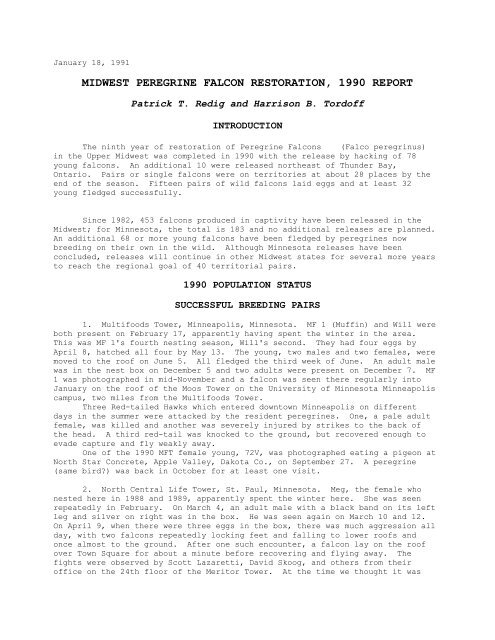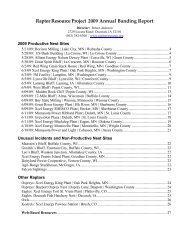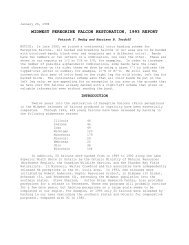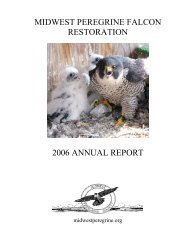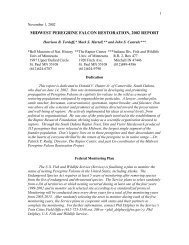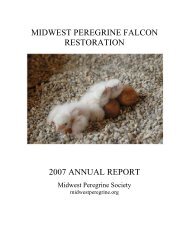1990 - Midwest Peregrine Falcon Restoration Project
1990 - Midwest Peregrine Falcon Restoration Project
1990 - Midwest Peregrine Falcon Restoration Project
You also want an ePaper? Increase the reach of your titles
YUMPU automatically turns print PDFs into web optimized ePapers that Google loves.
samples from the NCL and Ward young should prove whether Maverick sired bothbroods. One inconsistency is that the late 1989 NCL male was reported byTordoff to have a silver, not gold, band on its right leg, but this may havebeen an error. When Beaner was trapped in <strong>1990</strong>, the gold anodizing on his bandwas too faded to be reliably seen under field conditions.Since there were three eggs on April 9, the fourth was probably laid April10 or 11; three hatched by May 14. The young, two females and one male, weremoved to the roof on May 30, where they fledged around June 21. Both femaleyoung got severe Trichomonas infections ("frounce"), which is common in pigeons,were picked up weakened on the street in early July, and died at The RaptorCenter. The young male seemed unaffected and was seen at the nest box on July30.Two adult peregrines were still at the NCL tower in early December. OnNovember 23, Chase, 06T, from Rochester was picked up on the ground with abroken wing one block west of the NCL tower, presumably injured by the residentfalcon(s). For details, see account 23 below.3. Control Data Corporation Headquarters, Bloomington, Hennepin County,Minnesota. The 1989 peregrines, female 08V and male 04T, returned on March 10,<strong>1990</strong>. They ignored the box installed in 1988, so we gave them a gravel tray ona favorite ledge on April 6. Three eggs were laid by April 20, one hatched byMay 17 (the others had dead embryos). We added two young from Bob Anderson andmoved the brood, all females, to the nest box on June 8. All fledged aroundJune 27. One young flew into the glass-walled building and was killed on June30. Another, 74V, killed a pigeon and was captured for positive identificationand released by Ken Wagner in Andover, MN, 30 miles north of Bloomington, onSeptember 1. A nest box has been placed at a new location on the roof of thenorth wing of the building to eliminate the problem of confusing reflectionsfrom the glass walls which apparently deterred the falcons from using the oldbox in <strong>1990</strong>.4. NSP King Power Plant, Bayport, Minnesota. An adult male arrived atthe nest box on the smokestack on March 12. He was joined by an immature femaleon March 20; they turned out to be half-siblings, 31V, Mae, female produced byMF1 and Will in Minneapolis in 1989 and 13T, male, produced by MF1 and Alfie inMinneapolis in 1988. By April 23 they had three eggs; none had hatched by May30, when the female was seen on a TV monitor to eat one egg. Two male youngfrom Bob Anderson placed in the box were adopted immediately. They fledgedaround June 28. The female, 31V, seemed casual about incubation, spending longperiods away from the nest and standing over the eggs instead of incubating themduring the period when they should have been hatching, behavior probablyreflecting her immaturity. One adult was seen at the nest box on September 29.A peregrine thought to be a male was seen by Paul Simonet near the NSP plant onJanuary 8, 1991.5. Montgomery Ward, St. Paul, Ramsey County, Minnesota. This new pairwas reported by Tom Shearen, who works in the building, on May 3. The male is05T, Maverick, released at Rochester, Minnesota, in 1988; the female is 11V,Comet, released at Virginia, Minnesota, in 1988. They laid three eggs on tarroofing material on the upper ledge of the 250 foot tower which we transferredto a gravel tray. One hatched June 9 after at least 36 days of incubation.This male chick and one additional male from Bob Anderson were put in the trayin front of a new nest box on the east side of the tower. Both fledged aroundJuly 20; one fell down a large nearby smokestack but was rescued and releasedunharmed, the other was killed in a collision with the MW building on August 14or 15. For possible earlier history of Maverick, see pair 2, NCL, St. Paul,above.
6. Palisade Head, Lake County, Minnesota North Shore. Two adultperegrines were seen by a rock climber on a new nest ledge north of the parkinglot on May 1, when the nest contained two eggs. On May 6, Tordoff read thebands on both adults; they are Larry and Fridge, both nesting here in 1988 and1989. The clutch of four eggs hatched in early June and the four young, threefemales and one male, fledged around July 12. Late in the nestling period, theadults brought at least 14 gulls, apparently all Ring-billed Gulls, to the broodand remains of other peregrine-killed gulls were found by residents living justnorth of Palisade Head. It will be interesting to see if there is any effect ofeating gulls on egg-shell thickness in future years. Gulls are known to storehigh levels of pesticide residues in their fat. This pair of falcons seemed touse gulls for food for only a few weeks during the last half of the nestingperiod when four young needed feeding. There was no evidence of gull use bythese individuals in 1988 or 1989, with broods of two and one. Perhaps briefepisodic consumption of gulls will be less harmful to the adults and young thanwould be more consistent use.Three young were seen at the nest cliff on August 5 by Dudley Edmondson.7. Mt. Leveaux/Mt. Oberg/Homer Lake, Cook County, Minnesota. For threeyears, we have been outwitted by a pair of adult peregrines in this area. In1988 there was no evidence of nesting; in 1989, at least one young was fledgedfrom an unlocated nest; this year, a pair was reported on Mt.Oberg by JimCarlson on May 20 but could not be found there in later searches. On August 12,Dan Taylor saw three juvenile peregrines and one adult, probably male, on HomerLake, off the Caribou Trail, about 19 miles north of Mt. Oberg. It is only aguess that just one pair is involved in these events; none of the birds has beenidentified.On September 2, Dudley Edmondson saw an adult peregrine drive a BroadwingedHawk into the woods at Mt. Leveaux.8. Environmental Learning Center, Finland, Lake County, Minnesota.Although a pair was present here in 1989, the adults that nested here in <strong>1990</strong>were apparently two new birds (1989 male reported to have red band on one leg,dark band on other; <strong>1990</strong> male had green band on left leg, right leg bare,indicating release at Mt. Leveaux in 1985 or 1986: 1989 female a one-year-old;<strong>1990</strong> female apparently is 20P, Blueberry, released at Virginia, Minnesota in1987. 20P is a peregrinus X pealei female from Jack Oar; she might have shownenough immature plumage in 1989 to have been taken for a one-year-old). Thepair arrived on April 14 and moved into a nest box placed on a cliff at WolfLake in 1987. Four eggs were being incubated by April 26 and hatched in lateMay. On June 15, part of the rotted bottom of the box and three of the fouryoung fell to the rocks below when the young were being banded. Two of thechicks, one male and one female, were killed; the other two, also one male andone female, were unharmed and went on to fledge without further incident.9. First Wisconsin Center, Milwaukee, Wisconsin. McArthur, 03Y, andSibella, 20V, apparently spent the winter here. This was McArthur's thirdnesting season, the second with Sibella. They produced four eggs by April 6,all hatched, and four young (three females, one male) fledged in late June.10. Cline Avenue at Lake Michigan, East Chicago, Indiana. The same pairof peregrines that nested here in 1989 remained through the winter and nestedagain in <strong>1990</strong>. The first attempt, in an expansion joint under the highway, waswashed out in heavy rains on May 9-10. They renested in the same cave-likeopening under the highway overpass that they used in 1989 and fledged two youngmales from three eggs in early August. One young, 32X, was killed by a car onthe bridge the day after fledging. Both adults were captured for blood sampling
on July 17: the male is Floydy, 34Y, released in Milwaukee in 1987; the femaleis Phoenix, 08P, released in Fort Sheridan, Illinois, also in 1987. Their IDnumbers are consistent with the partial numbers read in 1989.There is also the possibility of another Indiana pair about nine milesfrom the Cline Avenue pair. An observer reported seeing a pair and young duringthe summer. An Indiana DNR person sent to the site reported suitable habitatand saw an adult peregrine in the vicinity. No further details are available.11. Commodore Perry Motor Inn, Toledo, Ohio. At this site two young werefledged in 1988, none in 1989, and one in <strong>1990</strong>. A second young died in the nestin <strong>1990</strong>. The <strong>1990</strong> pair included the same female as in 1988 and 1989, releasedin St. Catherine, Ontario, in 1987, and an unidentified male.12. Winnipeg, Manitoba. The same adults as in 1989 (Maud, 27P, and amale released in Winnipeg in 1985) nested again and produced two young from foureggs. One of Maud's 1989 young, a male, was present in <strong>1990</strong> on the Universityof Manitoba campus (see pair 22 below). According to Robert Nero, a malereleased at the University of Manitoba campus in 1989 helped a female raise twofoster chicks at Edmonton, Alberta, in <strong>1990</strong>.On December 17, Nero reported identifying a new adult female (52V),released in Cedar Rapids, Iowa, in 1989, in the downtown Winnipeg territory,setting the stage for a territorial conflict next spring if the old pair returnsto find an interloper. The new bird, present since early fall, was seen as lateas December 20.UNSUCCESSFUL BREEDING PAIRS13. Northern Building (recently renamed 125 S. Wacker Bldg.), Chicago,Illinois. For the third year, a pair nested at this site. The female isHarriet, who nested here in 1988 and 1989; the male is unidentified. The pairproduced four eggs, the first on March 19. Three young hatched, but the chicksdisappeared around May 4 at eight days of age, cause unknown. The adults didnot renest.14. Trap Hills, Bergland, Ontonagon County, Michigan. A pair of adults,at least one with a black band indicating <strong>Midwest</strong> release, nested on the cliffwhere a pair was present in 1989 and where releases were made in 1988 and 1989.Their behavior indicated that young were hatched, but the nesting failed,perhaps because of predation on the young.15. Porcupine Mountains, about 5 miles west of Silver City, OntonagonCounty, Michigan. A pair of adults, at least one with a black band, nested on acliff. Adults were seen bringing food to the nest ledge, but the youngdisappeared, perhaps casualties of a severe storm in early July.NONBREEDING TERRITORIAL PAIRS16. Detroit, Michigan. The male, Solo (20Y), was mated in 1988 to Bogeyand in 1989 to a female, 3B1, released in Montreal in 1984; the two 1989 nestingattempts failed. On March 22, <strong>1990</strong>, a new female, unbanded and adult-plumaged,appeared and 3B1 disappeared from Solo's territory. The new female remained atleast until May 30. Copulation was seen several times in early April andpotential nest sites were visited, but no nesting was attempted. The female'sbehavior toward Solo appeared fairly aggressive. An unidentified femaleperegrine was seen with Solo on July 20, but he seemed to be unpaired for therest of the summer.
17. Little Trout Bay, off Cloud Bay, between Thunder Bay and U.S. border,Ontario. Gordon Cameron, Ontario MNR, reported a pair, adult male and immaturefemale, seen in mid June on a remote lakeside cliff. No further detailsavailable.18. Duluth, Minnesota. A pair of peregrines defended the Richard BongBridge between Duluth and Superior, Wisconsin, in late May, harassing a highwaycrew most of one day. Dave Evans visited the site later and could find nocertain evidence of nesting but thinks the pair may have had a nest that wasabandoned as a result of the day-long invasion of their territory by the highwaycrew. Later in the summer and early fall, a female peregrine with a black bandwas present around grain elevators farther north in Duluth harbor.19. Pictured Rocks National Lakeshore, Alger County, Michigan. Anunidentified pair was present early in the season but did not nest. Releasesplanned for this location were moved to Isle Royale.20. Hyde Park, south Chicago, Illinois. A pair of peregrines was presentmuch of the summer but did not nest. One member of the pair is unbanded, theother has at least one band, aluminum on the left leg. A nest box may beinstalled for use in 1991.21. Chicago, Illinois. Since at least February, 1988, a rehabilitatedmale, Pacer, released in Chicago in 1986, was paired with a female, Zoar, P32,released in Milwaukee in 1987. Their territory, occupied year around, centerson the Fisher Building, near Irving Park and Lakeshore Drive, where two nestboxes are available. Zoar was killed in a collision with a building on February18, <strong>1990</strong>. Pacer remained at the site until early June, when a new pairappeared: the new male is Pegasus, 14Y, released in 1987 at Fort Sheridan; thefemale is a one-year-old, ?42?, probably Silverstreak, 42V, from Illinois BeachState Park, 1989. The new pair remained all summer, copulating and using thenest box, but did not nest. Pacer's fate is unknown.22. Winnipeg, Manitoba. A one-year-old male produced by Maud and hermate in downtown Winnipeg in 1989 spent much of the summer and fall, <strong>1990</strong>, onthe University of Manitoba campus. He was joined in mid-September by a female,67P, released in 1989 in Omaha, Nebraska.SINGLE TERRITORIAL BIRDS23. Mayo Clinic, Rochester, Minnesota. An adult male, Chase, 06T,released at the Mayo Clinic in 1988, was present the entire season. A femalearrived on April 24, provoking much calling and food transfers, but she musthave had another destination in mind because she did not stay. Chase did notattract a permanent mate.At 4 a.m. on November 23, Chase was picked up from the ground at Mickey'sDiner, one block west of the North Central Life tower in St. Paul with afractured left carpometacarpus inflicted by a blow from above. The mostplausible explanation is that he was exploring greener pastures, having goneunmated in Rochester, and entered the territory of the St. Paul pair, both stillin residence. Presumably one of them dealt him a blow to the wing. Examinationof his left wing also disclosed an old fully healed fracture of the left radius,an injury which would have kept him flightless for at least a month. How did heget food through this period? Chase has recovered flying ability at The RaptorCenter; after conditioning he will be returned to the Mayo Clinic for release inFebruary, ready for a much needed improvement in his luck.
NATURAL BREEDINGSumming up the natural breeding in <strong>1990</strong>, 15 pairs nested, 12 (80%) ofwhich were successful. Thirty-two young were fledged (counting five young addedto three nests in the Twin Cities), 2.7 young fledged per successful pair, 2.1per nesting pair.Of the 15 nesting pairs, eight were on buildings, five on cliffs, one on asmokestack, and one under a highway overpass. Seven of the eight building pairssucceeded, as did three of the five cliff pairs, the smokestack pair, and thehighway pair. Of the 32 young fledged in the wild, all except the threeyoung at Homer Lake were banded.PEREGRINE RELEASES IN <strong>1990</strong>Minnesota. Five young from Bob Anderson were added to wild broods: two atControl Data, one at Montgomery Ward, and two at the NSP plant in Bayport. Allfledged successfully, but one was later lost at Control Data and one atMontgomery Ward, both in building collisions. Young added to wild broods arecounted in our totals as "wild-produced" rather than hacked to emphasize theirrearing by wild falcons rather than their captive origin.Wisconsin, Madison. Nineteen falcons were released in batches of seven,six, and six. All fledged successfully, although one, 68T, was later killedwhen hit by a vehicle near Madison and another, 70V, was found dead at WinthropHarbor, Illinois, on August 31. A female, 94P, released at Madison in July 1989was trapped and released by Ken Holkestad at Moose Mountain, north of Duluth,Minnesota, on September 30, <strong>1990</strong>.Michigan, Isle Royale National Park. Eighteen falcons were released and16 reached independence successfully. At Blake Point, six were hacked. AtFeldtmann Ridge, two batches of six were released; one youngster died shortlyafter release from unknown cause and another was killed after fledging by anavian predator, perhaps a goshawk.Ohio. Columbus. Eight falcons were released and four reachedindependence. One was lost in a building collision, two starved through failureto get back to the hack box, and one died of disease.Ohio. Cincinnati. Six falcons were released with five successfullyreaching independence. One bird failed to develop properly and is in captivity,perhaps to be released in 1991.Illinois. Glen Ellyn. Ten falcons were released at the College of DuPagein groups of six and four. All fledged successfully, but by the end of theseason four were lost, one to a predator, one to disease, and two to unknowncauses. One other falcon suffered a broken wing and is undergoingrehabilitation.Iowa. Cedar Rapids. Thirteen falcons were released from the Telecom*USAbuilding, in groups of seven, three, and three. A one-year-old male with ablack band on the left leg, silver on right, arrived with the first group,harassed the youngsters as they learned to fly, but did no damage. Two of theyoung were killed in building collisions, eleven reached independence.Nebraska. Omaha. Four peregrines were hacked from the Mutual of Omahabuilding; all dispersed normally. An adult male peregrine arrived at the hack
site when the young had been flying for about 12 days and remained for the restof the season. He was not aggressive to the young falcons.From mid-July to late summer, a peregrine was present in Lincoln. It wasreported to have a "brass" band; its origin is not known.Ontario. Thunder Bay. The Ontario Ministry of Natural Resources (ThunderBay District), Canadian Wildlife Service, and the Thunder Bay Field Naturalists,led by Harold Kish, cooperated in a release of 10 peregrines on a cliff inSleeping Giant Provincial Park, Sibley Peninsula, about 30 km east of ThunderBay. All fledged successfully, for an excellent two year total of 26 falconsreleased in the Thunder Bay district without any known losses.To sum up production for <strong>1990</strong> in the <strong>Midwest</strong>, 32 young were fledged bywild pairs and 88 young (including the 10 at Thunder Bay, Ontario, part of the<strong>Midwest</strong>ern population although not released under our auspices) were releasedfrom captive pairs, for a total of 120. Of these, 101, 84%, lived toindependence (74 hacked, 84%; 27 wild, 84%). Causes of deaths beforeindependence were: collision with buildings (5), killed by predator (2), disease(4), collision with vehicle (2), starvation because of failure to return to hackbox (2), developmental problem (1), unknown (3).EGG-SHELL THINNINGFour intact unhatched eggs were recovered in <strong>1990</strong>, two from the NSP pairin Bayport, MN, one from the Montgomery Ward pair in St. Paul, and one from theEast Chicago, Indiana, pair. These eggs, compared with the mean for eggs fromthe pre-1947 eastern U.S. peregrine population (Ratcliffe Index, 1.99), show nosignificant shell thinning (R. I.: NSP, 1.99, 2.08; MW, 2.01; E. Chicago, 3.0 -too high, perhaps not fully blown or dried). (The Ratcliffe Index combinesempty eggshell weight, length, and breadth to give a standardized index of shellthickness.)GENETIC ANALYSISWe have begun a genetic analysis of the new midwestern population ofperegrines, in order to measure inbreeding, outbreeding, genetic variation,changes in occupancy of territories, dispersal of adults and young, success ofthe different genetic stocks introduced, and long-term development of geneticstructure in the new population. Sharon Moen has raised the research funds andis doing the genetic work for the next two years as a PhD project. In <strong>1990</strong>, shecompiled pedigrees from data supplied by the falcon breeders and visited LosAlamos National Laboratory to learn DNA fingerprinting techniques from JonLongmire. She has extracted and purified DNA from over 150 peregrine bloodsamples and "fingerprinted" 40 peregrines.We collected blood samples in <strong>1990</strong> from 82 newly released peregrines, from25 wild young, and from eight wild adults. In addition, blood is beingcollected by the various breeders from the captive founders of the newpopulation.PLANS FOR 1991 AND BEYONDIn 1988, we suggested a new goal for the <strong>Midwest</strong>ern restoration effort of40 territorial pairs of peregrines for the nine state area (Minnesota,Wisconsin, Michigan, Nebraska, Iowa, Illinois, Indiana, Ohio, and Missouri) andwestern Ontario. Twenty-two pairs were on territories in <strong>1990</strong>. Judging byexperience with the restored eastern peregrine population and our five year
history of nesting birds in the <strong>Midwest</strong>, the population can be expected todouble every two to three years in its early growth stage and then quickly leveloff. In 1989 we predicted 20 to 22 pairs in <strong>1990</strong>; the actual count is 22. Forthe years ahead, we repeat our prediction made in 1989, namely, 26 to 30 pairsin 1991, 32 to 36 in 1992, with the goal of 40 pairs reached in 1993 or 1994,given releases at the 1989 level through 1991. Individual states each havetheir own goals, however, which will likely result in a tapering off of releasesin the <strong>1990</strong>s, rather than an abrupt termination.The general objective of the restoration effort is to establish a selfsustainingpopulation of <strong>Peregrine</strong> <strong>Falcon</strong>s, large enough to reduce or eliminatethe possibility of extinction through random events and sufficiently diversegenetically to provide adequate variation for natural selection. The size of afounder population is irrelevant to its survival if recruitment is not adequate.Large populations will disappear without recruitment; small populations willgrow with adequate reproduction. No one can be sure at what level the new<strong>Midwest</strong> population will stabilize, but this level will be reached without humanhelp once the general objective is met. The only biological benefit ofreleasing more falcons than the minimum needed to establish a safe, selfsustainingpopulation is to reach the present carrying capacity of the regionmore quickly and to distribute the birds across the region in a satisfactorymanner, although the final details of distribution will be determined by thefalcons themselves.ACKNOWLEDGEMENTSThe <strong>Midwest</strong> <strong>Peregrine</strong> <strong>Project</strong> is a cooperative effort involving manypeople and organizations. The University of Minnesota provides the overallcoordination and administration of the project through Dr. Pat Redig of theRaptor Center and Dr. Bud Tordoff of the Bell Museum. The Minnesota Chapter ofThe Nature Conservancy provides administrative support services and is involvedin critical peregrine habitat preservation. Other financial and logisticalsupport for the Minnesota part of the effort is provided by Minnesota DNRNongame Wildlife Program, Minnesota DNR Parks and Recreation, Endangered SpeciesOffice and Minnesota Cooperative Fish and Wildlife Research Unit of the U. S.Fish and Wildlife Service, U.S Forest Service, Minnesota <strong>Falcon</strong>ers Association,Iron Range Resources and Rehabilitation Board, Wolf Ridge Environmental LearningCenter, Mayo Clinic, Northwest Airlines, and BCED Minnesota in Minneapolis andSt. Paul. Each cooperating state and agency has, in addition, its own list ofcooperators, for which see the individual hack site reports. <strong>Falcon</strong>s areobtained from private falconer/breeders, listed in the appendix, throughoutNorth America. <strong>Falcon</strong>s were supplied through us to the Wisconsin, Michigan,Illinois, Ohio, Iowa, and Nebraska releases on a contract basis. The day to daydevoted care that makes hacking falcons successful was provided by the hack siteattendants listed in the appendix.APPENDIXBREEDERS SUPPLYING PEREGRINES FOR <strong>1990</strong> RELEASESRobert Anderson, Hugo, MinnesotaLes Boyd, Pullman, WashingtonJames Doyle, Arlington, TexasDon Hunter and Victor Hardaswick, Centerville, South DakotaJack Oar and Bruce Haak, Eagle, Idaho
Lynn Oliphant and Paddy Thompson, Saskatoon, SaskatchewanThe <strong>Peregrine</strong> Fund, Boise, IdahoRalph Rogers, Winnifred, MontanaSteve Sherrod, Bartlesville, OklahomaIndividuals<strong>1990</strong> CONTRIBUTORS TO PEREGRINE RESTORATION IN MINNESOTALinda FalchNorman L. FordLouis F. HillLouis W. Hill, Jr.Marion J. MengelElaine MellottTom and Toni ShearenHarrison B. TordoffRobert J. WilkieOrganizationsBCED MinnesotaBig Game Club Special <strong>Project</strong>s FoundationControl Data CorporationFriends of the Minnesota River ValleyMayo ClinicMinnesota DNR Nongame WildlifeMinnesota <strong>Falcon</strong>ers AssociationNorthwest AirlinesUniversity of Minnesota Graduate School Faculty Grant-in-AidU. S. Fish and Wildlife Service<strong>1990</strong> HACK SITE ATTENDANTSMichiganIsle Royale National Park, Blake Point: James Berkelman, James Garland.IRNP, Feldtmann Ridge: Marcus Koenen, Mary Maule.WisconsinMadison, Van Hise Hall, Univ. Wisc.:Milwaukee, First Wisconsin Center: Greg Septon and Annie Wendt.IllinoisGlen Ellyn, College of DuPage: Mary Ann Schmidt, Dan Bartley, SallyBaumgardner, David Bernier, Gwyn Boughner, Eileen Bunker, Donna Burdick, StevenBrockway, Vicki Byre, Hal Cohen, Phillip Collura, Elna Davis, Tom Doan, DidgeDonovan, Don and Donna Eisenmenger, Sandy Fejt, Antonella Gianni, Mary Hennen,Linda Hill, Russ and Sandy Kamine, Jim Kaney, Kathy Lucas, Leila Parts, BobbiPerkins, Sue Schultz, Herb Schulz, Janice Siska, Christine Stenson, TimStephenson, Jan Underwood.IowaCedar Rapids, Telecom*USA Building: Kristin VanRees, Wendy Van DeWalle.
OhioColumbus, Rhodes State Office Tower: Jeanette Bettinger, Pamela Claar,Martha Konidaris.Cincinnati, Commerce Center: Margaret Kelly, Stephanie Dubs, WilliamBrunner, Jenny Herbst.NebraskaOmaha, Mutual of Omaha Bldg.: Lauren Gilson, Jason McMeen.Table 6. PEREGRINE POPULATION GROWTH IN THE MIDWESTYearTotal Terr. Nest. Succ. Young Yg/n. Yg/s.rel. pairs pairs pairs fldgd pair pair1986 102 4 1 0 0 0 01987 170 6 3 1 1 .33 1.01988 254 13 8 6 12 1.5 2.01989 370 16 12 9 22 1.8 2.4<strong>1990</strong> 453 22 15 12 32 2.1 2.7Note: Starting in 1989, "young fledged" includes allyoung surviving to first flight from the nest.


